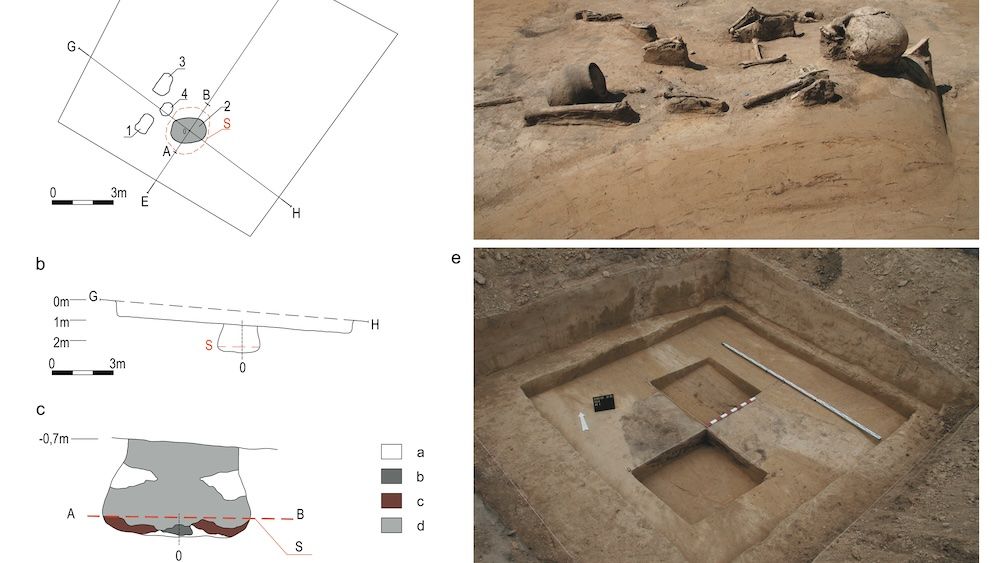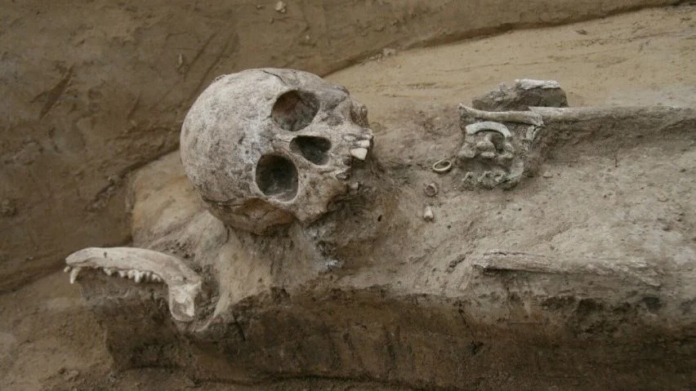The ancient world is filled with mysteries waiting to be unveiled, and the recent discovery of a 1,600-year-old double burial in Poland is one such captivating find. Unearthed in the village of Czulice near Krakow, this remarkable site sheds light on the enigmatic Hunnic people and their interactions with local European populations during their expansive migrations across the continent.
The Huns: A Formidable Nomadic Empire
The Huns, a powerful group of nomadic warriors originating from Central Asia, carved a fearsome legacy throughout Europe in the 4th and 5th centuries. Under the leadership of the infamous Attila the Hun, who was dubbed “the Scourge of God” by contemporaneous Christians, the Hunnic Empire stretched from modern-day Russia to France, subjugating and terrorizing the societies in its path.

The Czulice Burial: A Glimpse into Hunnic Culture
It is against this backdrop that the remarkable double burial discovered in Czulice, Poland, takes on profound significance. Led by archaeologist Jakub Niebylski of the Polish Academy of Sciences, the excavation in 2018 unearthed the grave of two boys aged between 7 and 9 years, buried alongside a wealth of grave goods and animal remains.
The Hunnic Influence
One of the boys, labeled Individual II, exhibited genetic affinities with present-day Asian populations, particularly nomads from Kazakhstan and Kyrgyzstan, and was determined to be of Hunnic origin. This discovery is particularly noteworthy, as it represents the oldest known Hunnic burial site in Poland, dating back to the period between CE 395 and 418 – a time that coincides with the Hunnic incursions into Europe, driven by climatic changes and the search for new resources.

Social Hierarchy Revealed
The Hunnic boy’s remains were particularly notable for the artificially deformed shape of his skull, a practice common among the Hunnic elite aimed at distinguishing their social status. This boy was buried with several valuable items, including a gold earring, silver buckles, a clay vessel, and an iron knife, indicative of his high status within the Hunnic social hierarchy.
In contrast, the other boy, labeled Individual I, was of local European origin, likely connected to the Pannonian Plain in modern-day Hungary. This European boy, who lacked grave goods, was found buried on his stomach, suggesting a lower social status, possibly as a servant or companion to the Hunnic boy.

Insights into Hunnic Customs and Interactions
The double burial also included the remains of a dog, a cat, and a crow, believed to be the boys’ animal companions for their journey into the afterlife. This aspect of the burial is unusual for the Huns and may reflect a borrowing from Roman funerary practices, hinting at the cultural interactions and exchanges between the Hunnic invaders and the local populations they encountered.
Further Analysis Reveals More Secrets
Through advanced analysis techniques, such as CT scans, X-rays, isotope testing, and ancient DNA analysis, researchers have uncovered even more details about the boys’ lives and origins.
The Hunnic boy’s lesions in his eye sockets suggested chronic anemia or another disease that may have contributed to his early death, providing a glimpse into the health challenges faced by the Hunnic elite. Isotopic analysis of the boys’ diets indicated that both had protein-rich diets, but the lack of grave goods for the European boy hinted at his lower social status within the Hunnic social structure.
The practice of cranial deformation, which the Huns adopted from the Alans, an ancient Iranian nomadic tribe, was a mark of aristocracy and elite status. This burial site in Czulice, therefore, provides a unique window into the cultural practices and social hierarchies of the Huns, as well as their interactions with local populations during their migrations into Europe.
Conclusion
The discovery of the 1,600-year-old double burial in Czulice, Poland, is a remarkable testament to the enduring legacy of the Hunnic people. This site not only sheds light on the cultural practices and social dynamics of the Huns but also highlights the complex interplay between the nomadic invaders and the local European populations they encountered during their expansive migrations across the continent.
As we continue to explore and unravel the mysteries of the past, sites like the Czulice burial serve as invaluable windows into the rich tapestry of human history, reminding us of the enduring spirit of those who came before and the importance of preserving and studying these priceless artifacts of our shared heritage.




